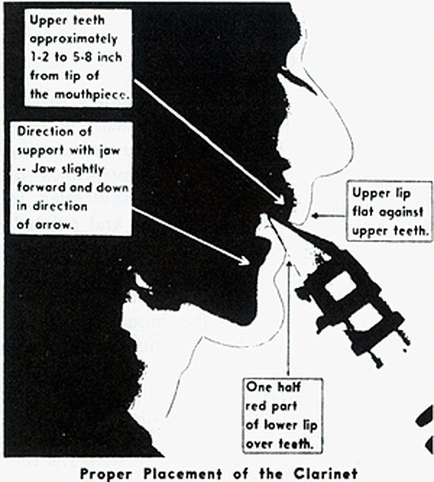 For years now, I have been working to make my Bb clarinet embouchure more stable. It is a difficult undertaking that demands a lot of patience. Switching to bass clarinet regularly only makes maintaing a truly solid Bb clarinet embouchure even more difficult. On top of that, it can be tough to find time to do maintenence when working as a professional clarinetist. The rigors of learning music for performances and attending rehearsals often leave my chops pretty toasted. Over the weekend I stumbled across an article written by Lucinda Lewis, a French horn player in the New Jersey Symphony Orchestra. The article talks about “Embouchure Overuse Syndrome,” how it is caused and how to fix it. The article is aimed entirely at brass players, but I did manage to pull some very useful information from the article. First, it is worth noting, that Ms. Lewis is not a medical doctor, and her claims seem to be largely conjecture, and are not the result of any scientific study. Here is an excellent rebuttal to Ms. Lewis’ claims. I’m not convinced that embouchure overuse syndrome is a real thing, nor am I convinced that it can be achieved in a clarinet player. I do believe that as clarinetists, we can make small changes in our embouchures over time to overcome equipment deficiencies, or other bad habits. For example, I currently play a Buffet Festival Bb clarinet. The instrument is designed with a slightly higher register tube vent than a standard R13. As a result, the notes from clarion A to C are on the low side. Over the past year, I have increased my embouchure pressure while playing in that region of the instrument. It’s not something I decided to do, but that is the easiest way to bring those notes up to pitch, so I did it without making a conscious decision to do so. (Update: I’m now playing an RC Prestige) After reading Ms. Lewis’ article, I got an idea for an embouchure exercise that has helped me tremendously. She suggests blocked buzzing for brass players, where the player buzzes on the mouthpiece alone, then covers the entire end of the mouthpiece with their hand to completely stop the flow of air. This lets the player completely concentrate on forming the embouchure and provides very few variables to get in the way. I adapted this to Bb clarinet with excellent results. To do this on clarinet, take the mouthpiece, with reed attached and barrel off of the instrument. Sit or stand in ideal playing posture in front of a mirror. Take a deep breath, expanding your stomach as you do so. Form your embouchure around the mouthpiece. Completely cover the end of the barrel with the palm of your hand. Support your air with your diaphragm and blow. No air should escape, especially not from your embouchure. Concentrate on the different aspects of your embouchure as you hold it. First on your top lip, be sure it is rounded and pressing firmly into the mouthpiece. Next ensure your corners are pointed either down or into the mouthpiece. Next, concentrate on your chin, is it flat? How is your bottom lip? Last, ensure you are not using your teeth as an integral part of your embouchure. This is a very zen-like exercise. I tend to concentrate on one aspect of my embouchure for 30 seconds on the metronome, then take a breath and repeat with the next part of my embouchure. The goal is to remind yourself exactly what this is supposed to feel like so that when you are in the thick of it in a concert, you can think about playing beautiful music, not making sure you have a firm top lip. For me, doing this exercise let me realize that I had switched to reeds that were too soft. I was in search of a free-blowing setup, but this does not allow me to form my embouchure the way I want to. I imagine everyone that tries this will have different results, but it is a great tool for doing a mental embouchure check.
0 Comments
|
AuthorWrite something about yourself. No need to be fancy, just an overview. Archives
February 2017
Categories |
 RSS Feed
RSS Feed